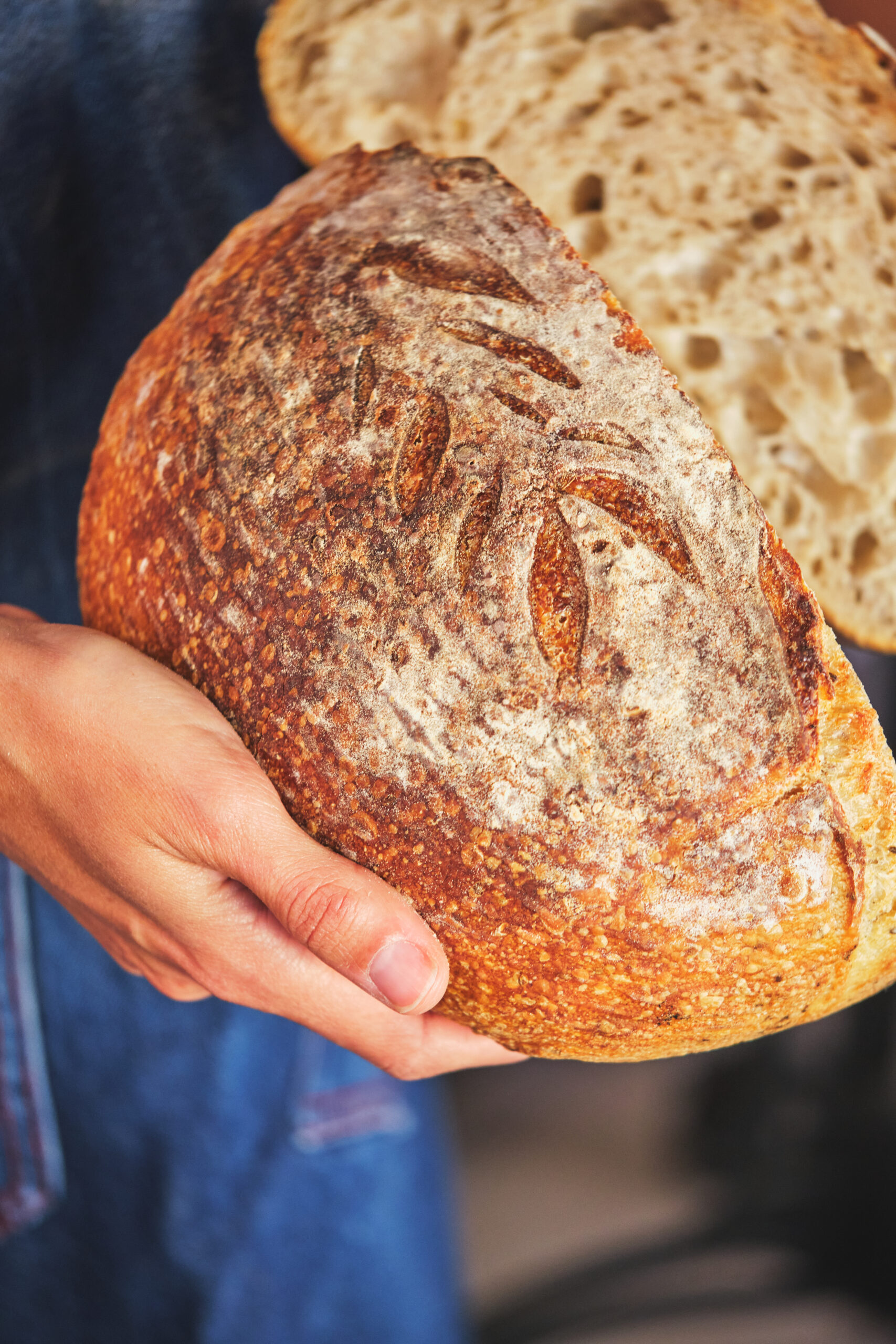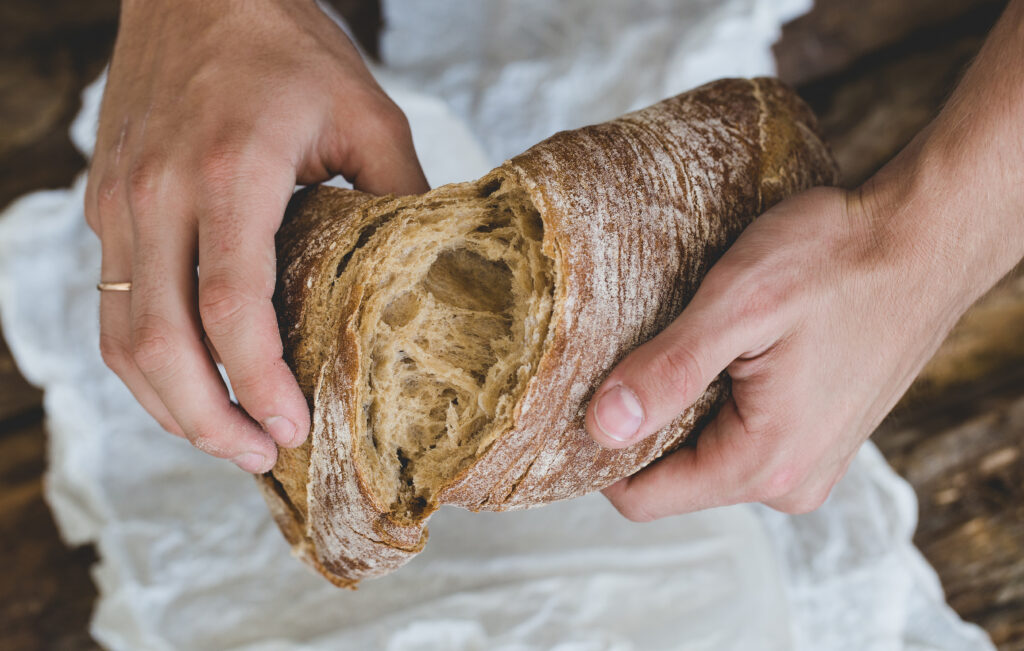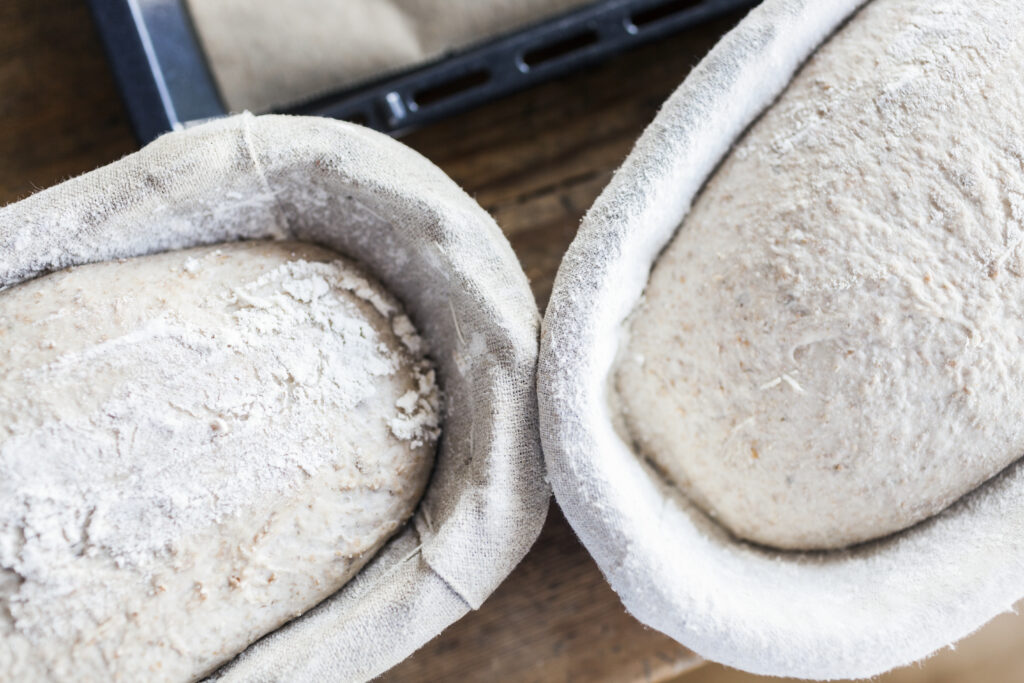Understanding Sourdough Discard
What is Sourdough Discard?
Results from the maintenance of a sourdough starter. Typically, you remove a portion of the starter before each feeding. This helps control its size and microbial balance. Unlike the active starter, the discard might have fewer live microbes since it comes from the culture before it gets fed.
The Process of Creating Sourdough Discard
Maintaining a sourdough starter involves a routine cycle to keep it healthy and active. Here’s how you create :
- Feeding the Starter: You begin by adding equal parts (by weight) of flour and water to the starter. This refreshes the nutrients available to the yeast and bacteria.
- Growth Period: Next, the starter ferments at room temperature for several hours. This fermentation allows the microbes to eat the new flour and water, multiply, and produce gas. This gas makes the starter rise.
- Removing Excess: Before the next feeding, you remove some of the starter. This step controls its volume and acidity. The portion you remove is the “discard.”
- Continuing the Cycle: You repeat this process regularly. By doing so, you ensure the starter remains vigorous and ready for baking.
This process not only helps in producing better sourdough bread but also makes the discard a versatile ingredient. You can use it in various recipes, adding unique flavors and nutritional benefits.
Nutritional Profile
Comparison of Nutritional Benefits: Discard vs. Starter
When comparing sourdough discard to a fully-fed sourdough starter, significant differences in nutritional content emerge. Both contain similar basic components—flour and water—yet their microbial activity levels vary, which can affect their nutritional values.
typically removed before feeding, often has lower levels of active yeast and bacteria. This difference means it may have slightly reduced levels of certain B vitamins and minerals that are produced during peak microbial activity. However, discard still retains a substantial part of the nutritional profile of the flour used, which includes fiber, iron, and selenium.
A fully-fed starter, in contrast, being at the height of its fermentation cycle, often showcases enhanced synthesis of B vitamins like folate and biotin, which are crucial for energy metabolism and skin health, respectively. It may also feature higher levels of antioxidants that develop during yeast fermentation.
Health Benefits of Sourdough Discard
Despite being less active than the starter, still offers various health benefits. One of the most notable is its probiotic potential. Although the bacteria levels might be lower, they still contribute to gut health by helping to balance the intestinal flora.
Additionally, sourdough discard contains prebiotic fibers. These fibers help nourish beneficial gut bacteria, further supporting digestive health. The fermentation process also helps to reduce the phytate levels in flour, which can improve mineral absorption and digestion.
Moreover, sourdough discard can be a source of omega fatty acids, depending on the type of flour used. These fatty acids are essential for heart health and cognitive function.
Using sourdough discard not only minimizes waste but also provides a way to enjoy the subtle tang and nutritional benefits of sourdough without baking a full loaf. Its versatility in recipes—from pancakes to crackers—allows for easy incorporation into a healthy diet.
Culinary Uses
Flavor and Texture Contributions
can significantly enhance both the flavor and texture of various recipes. It imparts a distinctive tangy flavor, a hallmark of sourdough products, which can add a new depth to many dishes. This slight acidity can balance the sweetness in recipes like muffins and cakes, providing a complex flavor profile that is both rich and satisfying.
In terms of texture, acts as a tenderizer. It contains enzymes that break down gluten, which can make baked goods like pancakes and breads softer and more delicate. Additionally, the fermentation process involved in creating sourdough discard produces organic acids, which can help to lighten the texture of doughs and batters by interacting with baking soda or baking powder used in recipes, leading to better rise and a fluffier texture.
Popular Recipes Using Sourdough Discard
Sourdough Muffins: Sourdough discard can be used to make wonderfully soft and flavorful muffins. The discard contributes to a moist texture while adding a slight tang that complements both sweet and savory varieties. You can customize sourdough muffins with ingredients like blueberries, chocolate chips, or cheese and herbs for a delicious twist.
Sourdough Cakes: Integrating sourdough discard into cake batters results in a tender crumb and a unique flavor complexity that enhances traditional cakes. Whether it’s a chocolate cake or a vanilla sponge, adding can elevate the ordinary into something extraordinary. The natural acidity of the discard also helps in leavening, aiding in a lighter, airy texture.
Sourdough Bread: While traditional sourdough bread uses an active starter, using discard in bread recipes is a fantastic way to achieve a similar sourdough taste without the same level of rise. It’s perfect for making flatbreads, focaccias, or even artisan loaves, where a denser texture and deeper flavor are desired.
Pancakes and Waffles: Using sourdough discard in pancakes and waffles adds a delightful tang and fluffiness to your breakfast. The natural leavening properties of the discard mean you often don’t need additional baking powder or soda, resulting in a naturally leavened treat that is both delicious and satisfying.
These uses showcase the versatility of sourdough discard, making it a valuable ingredient in a wide range of recipes. By incorporating discard into your cooking, you not only reduce waste but also enrich the flavor and texture of your dishes, making them stand out with minimal extra effort.
Evaluating Health Benefits
Digestive Health Benefits
a by-product of sourdough starter maintenance, offers several digestive health benefits due to its fermentation process. The fermentation that occurs in discard involves lactic acid bacteria breaking down the carbohydrates and proteins found in flour. This process pre-digests some of the gluten and starches, making sourdough products easier to digest compared to those made from regular baker’s yeast.
Furthermore, the organic acids produced during fermentation can help to lower the bread’s glycemic index, resulting in slower blood sugar spikes. The presence of these acids also enhances the bioavailability of minerals such as magnesium and phosphorus by reducing phytate content, which can inhibit their absorption.
Another significant benefit comes from the probiotics (live beneficial bacteria) that are present in the discard. While baking at high temperatures may reduce their concentration, these probiotics contribute to a healthy gut microbiota when consumed in ample amounts from active cultures. A balanced gut microbiota is crucial for good digestive health and can improve overall immune function.
Potential Risks and Considerations
While discard offers numerous health benefits, there are some risks and dietary considerations to keep in mind:
Gluten Content: Despite the fermentation process, still contains gluten, which can be problematic for individuals with gluten-related disorders, such as celiac disease or non-celiac gluten sensitivity. It’s important for these individuals to avoid sourdough products unless specifically made with gluten-free ingredients.
Acidity: The natural acidity of sourdough discard, while beneficial in many ways, might not suit everyone, especially those with sensitive stomachs or conditions like gastritis or acid reflux. The acidic nature of sourdough can potentially aggravate these conditions.
Allergens: Depending on the type of flour used to make the sourdough discard, there could be allergens involved, such as wheat, which is a common allergen. People with allergies or intolerances to specific grains used in the sourdough mixture should exercise caution.
Carbohydrate Content: For individuals watching their carbohydrate intake, such as those with diabetes, it’s essential to consider that still contains similar carbohydrate levels to regular flour preparations. Monitoring portion sizes and overall daily carbohydrate consumption is critical.
In conclusion, while discard is a healthful ingredient that can enhance various recipes, it is important for individuals with specific dietary restrictions or health conditions to consider these potential risks and discuss their diet with a healthcare provider to ensure that sourdough discard is a safe and beneficial choice for them.
Debunking Common Myths
Misconceptions About Health Impacts
Several myths surround sourdough discard, especially regarding its health effects. Here, we address and clarify some of the common misconceptions to provide a clearer understanding of its benefits and limitations.
one : Sourdough Discard is Unhealthy Due to High Acidity
- Reality: While it’s true that has a naturally acidic pH due to the fermentation process, this doesn’t necessarily make it unhealthy. Organic acids such as lactic acid actually enhance flavor and may lower the glycemic index of foods. For most people, the acidity in sourdough discard isn’t a cause for concern unless they have specific health conditions that make them sensitive to acidic foods.
Two : Sourdough Discard is Completely Gluten-Free
- Reality: A common belief is that the fermentation process in sourdough discard completely breaks down gluten, rendering it gluten-free. However, fermentation does reduce the gluten content, but it does not eliminate it entirely. Therefore, sourdough discard still contains gluten and should not be considered safe for those with celiac disease or severe gluten sensitivities.
Three : Sourdough Discard Can Replace Probiotic Supplements
- Reality: Sourdough discard contains beneficial lactic acid bacteria, although at levels much lower than what you might find in commercial probiotic supplements. Furthermore, most of these bacteria are likely to be killed by the high temperatures used in baking, reducing their potential benefits as probiotics.
Four : Sourdough Discard is Nutrient-Depleted
- Reality: Contrary to some beliefs, is not nutrient-depleted. It retains most of the nutrients found in the flour used, such as B vitamins, iron, and fiber. Some minerals’ availability may even be enhanced by the fermentation process.
By understanding the real facts about sourdough discard, individuals can better integrate this ingredient into their diets and enjoy its unique flavors and textures without misconceptions influencing their choices. It’s important to approach as a valuable resource that, when used properly, can contribute positively to dietary variety and enjoyment.
FAQs
Frequently Asked Questions
What are the best uses for sourdough discard in baking? is versatile and enhances many baking recipes. It adds a slight tanginess to pancakes, waffles, muffins, and flatbreads. You can also use it in cakes, cookies, and desserts to improve moisture and tenderness. Try adding discard to pie crusts for deeper flavor and better flakiness.
Does sourdough discard have the same health benefits as the starter? shares some health benefits with the starter, but differences exist due to its fermentation stage. Both contain beneficial lactic acid bacteria that support digestion and gut health. However, discard might have fewer active bacteria and enzymes because it is removed before feeding. It still provides a good source of the vitamins and minerals in the flour.
How long can you store sourdough discard? You can keep sourdough discard in the refrigerator for up to a week. For longer storage, freeze it for several months. Thaw frozen discard in the refrigerator overnight before using. Always use an airtight container to store discard and keep it fresh.
Culinary Uses of Sourdough Discard
Not only is sourdough discard beneficial for health, but it also adds a unique tang and texture to various recipes. Whether you’re making fluffy pancakes or a rustic loaf, incorporating sourdough discard can enhance the flavor profile of your baked goods, making them stand out with a gourmet touch.
Health Benefits of Sourdough Discard
Sourdough discard isn’t just a by-product to throw away. It is a rich source of probiotics that enhance gut health and improve digestion. The lactic acid bacteria in sourdough discard help in maintaining a balanced gut flora, which is essential for optimal digestive health. For a deeper understanding of how sourdough affects health, see this comprehensive resource on Wikipedia.
Sourdough Discard Myths Debunked
Contrary to common misconceptions, is not devoid of nutritional value. It contains essential nutrients such as iron and B vitamins that are crucial for energy metabolism and cognitive function. Moreover, the idea that sourdough discard is harmful due to its acidity is a myth; the pH level of sourdough discard is perfectly safe for most people and can actually aid in mineral absorption and digestion. Learn more about the unique properties of sourdough discard from the Songs of a Sourdough and the history of Carl Griffith’s 1847 starter.












